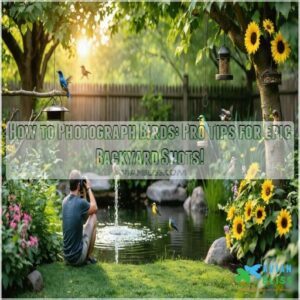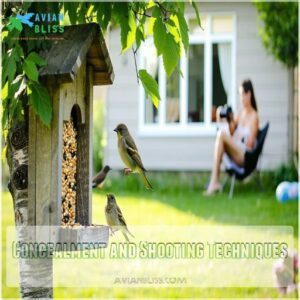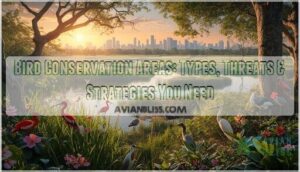This site is supported by our readers. We may earn a commission, at no cost to you, if you purchase through links.
 Want epic backyard bird shots? Start by transforming your outdoor space into a feathered paradise. Plant native greenery, set up strategic bird feeders with sunflower seeds and nectar, and add a small water feature to attract diverse species.
Want epic backyard bird shots? Start by transforming your outdoor space into a feathered paradise. Plant native greenery, set up strategic bird feeders with sunflower seeds and nectar, and add a small water feature to attract diverse species.
Position yourself near natural perches, ideally from a second-floor window or a camouflaged spot. Use a full-frame camera with a 200-600mm lens and tripod for crisp images.
Master the golden hours of morning and evening light, and learn bird behavior patterns. Patience is your best friend—wait for those perfect moments when your winged subjects strike a pose. Pro tip: your backyard’s about to become a wildlife photography studio.
Table Of Contents
- Key Takeaways
- Attracting Birds Home
- Photographing Birds Backyard
- Choosing Camera Equipment
- Creating Photogenic Scenes
- Mastering Bird Photography
- Frequently Asked Questions (FAQs)
- Can a backyard be a good place for bird photography?
- What is a good backyard setup for bird photography?
- How can I improve my backyard bird photography?
- How do you take a good bird photo?
- Does the background matter in bird photography?
- Should you photograph birds close to home?
- How to photograph birds without scaring them?
- What is the best setting for photographing birds?
- What is the rule of birds photography?
- How do you get backyard birds to trust you?
- Conclusion
Key Takeaways
- Set up your backyard with native plants, feeders, and water features to attract a variety of birds.
- Use a camera with a long lens (200-600mm) and a tripod for sharp, detailed shots.
- Position yourself strategically, staying camouflaged or shooting from a window for natural, undisturbed photos.
- Take advantage of golden hours and understand bird behavior to capture their best moments.
Attracting Birds Home
Want to transform your backyard into a bird photography paradise?
Transform your space into a feathered photo studio by strategically placing native plants, water features, and irresistible seed offerings that’ll have local birds flocking to your lens.
Bird Feeders and Seeds
Strategically choose birdseed to turn your backyard into a bird photography hotspot. Different seed types like sunflower, safflower, and nyjer attract unique species.
Using the right bird feeders can also make a significant difference in attracting various bird species. Position your backyard bird feeders carefully, experimenting with seasonal blends to maximize wildlife variety.
Maintain clean feeders to keep birds coming back, creating perfect opportunities for capturing stunning, up-close shots of your feathered friends.
Building Bird-Friendly Habitat
Transform your backyard into a bird paradise with native plants that roll out the welcome mat for feathered friends.
Smart habitat creation means choosing local greenery that provides shelter, food, and comfort.
A small water feature can work magic, turning your yard into a magnet for diverse bird species and creating the perfect natural studio for your photography dreams.
By incorporating bird habitats with the right plants and water features, you can attract a wide variety of birds to your yard.
Offering Multiple Food Sources
With a sprinkle of strategy, set up different backyard bird feeders to turn your space into a photography paradise.
Multiple feeder types reduce resource competition and attract diverse bird species. Utilizing multiple bird feeders can greatly enhance the overall bird-watching experience.
By carefully placing sunflower seeds, suet, and nectar feeders, you’ll create a buffet that keeps winged visitors coming back, giving you more chances to capture those epic shots.
Photographing Birds Backyard
After setting up your bird-friendly habitat, it’s time to turn your backyard into a photography paradise. Capturing stunning bird photos isn’t just about luck—it’s an art form that requires strategy and patience. With the right approach to backyard bird photography, your backyard can become a wildlife studio. To achieve professional results, consider visiting bird photography tips and guides for expert advice.
Key elements to nail your garden bird photography:
- Position yourself strategically near natural perches
- Understand the golden hours of morning and evening light
- Create an inviting, unobtrusive shooting environment
- Learn bird behavior patterns in your specific yard
Lighting makes or breaks your shot. Aim to shoot when the sun sits behind you, illuminating your feathered subjects perfectly. Watch how birds move, anticipate their landing spots, and blend into the background. Your yard is now more than a garden—it’s a living canvas waiting to capture nature’s most dynamic moments.
Choosing Camera Equipment
For bird photography, you’ll want to invest in the right gear that’ll help you capture those breathtaking backyard moments.
Your camera setup can make the difference between a blurry blob and a stunning wildlife shot, so let’s explore the essential equipment that’ll turn you into a backyard bird photography pro.
Focal Length and Lens Selection
Ready to level up your backyard bird photography lens game? Choosing the right focal length can make or break your shot.
Pro tip: aim for 500mm or 600mm to get those crisp, detailed images.
Full-frame cameras paired with 200-600mm lenses work wonders, while crop-frame setups shine with 100-400mm glass.
Teleconverters can help, but watch for quality dips.
Tripod and Gimbal Support
In the field of bird photography, your tripod and gimbal head are your secret weapons for capturing crisp, sharp images. Here’s why these camera mounts are game-changers:
To find the perfect gimbal tripod head for your needs, consider factors such as weight capacity and mounting style.
- Gimbal heads balance heavy telephoto lenses effortlessly
- Smooth lens movement tracks fast-flying birds
- Stabilizes camera for pin-sharp wildlife shots
- Provides precise control during tricky shooting conditions
- Reduces arm fatigue during long photography sessions
Choose wisely, and your lens will dance like a pro with crisp, sharp images and pin-sharp wildlife shots.
Creating Photogenic Scenes
Want to turn your backyard into a bird photographer’s paradise? You’ll need to master the art of creating irresistible, natural-looking scenes that’ll make your winged subjects feel right at home.
Natural Perches and Branches
Crafting the perfect branch placement transforms backyard bird photography from mundane to magical.
Natural tree limbs strategically positioned near feeders become irresistible landing spots for feathered friends.
Understanding local bird species is essential for creating an environment that attracts a variety of birds.
Choose sturdy, textured branches that blend seamlessly with your nature scenery, creating photogenic perches that invite birds to pause and strike a pose for your lens, making backyard bird photography and the use of feathered friends a great experience.
Concealment and Shooting Techniques
After perfecting your natural perches, mastering concealment becomes your next move.
Camouflage is key in bird photography, so grab a photography blind or drape yourself in beige or green.
Use window corners, house edges, or portable blinds to hide.
To capture stunning images, consider setting up a bird feeder that attracts various species.
Clean your window, set up a remote shutter, and position yourself strategically to capture those stunning feathered moments without spooking your subjects.
Mastering Bird Photography
You’ve got the skills to transform your backyard into a bird photography paradise, where patience and technique combine to capture stunning wildlife moments.
With the right approach, you’ll soon be snapping epic shots that showcase the vibrant personalities and breathtaking beauty of your feathered neighbors.
Technical Aspects of Photography
Once you’ve perfected your perch setup, mastering camera settings becomes your next bird photography challenge.
Shutter speed, aperture, and ISO are your secret weapons.
Aperture-Priority Mode lets you control depth of field while keeping shutter speed flexible.
Bump up your ISO in low light, but watch for noise.
Quick camera focus and exposure compensation can turn good shots into great bird photography magic.
Patience and Planning
Every masterful backyard bird photograph hinges on patience and planning.
Your waiting techniques matter more than fancy gear.
Learn to move slowly, blend into the background, and understand bird behavior during morning sessions.
To improve your skills, studying bird photography techniques can greatly enhance your ability to capture stunning images.
Stay quiet, observe carefully, and let the birds come to you.
Positioning yourself strategically transforms ordinary moments into extraordinary bird photography shots.
Conservation and Photography Ethics
As your patience pays off in capturing that perfect shot, remember: wildlife protection isn’t just a buzzword—it’s your responsibility.
Bird welfare trumps getting the picture. Respect their space, follow conservation efforts, and minimize environmental impact.
To learn more about photography ethics and responsible practices, explore resources that promote bird conservation. Your ethical photography can inspire others, turning each click into a powerful statement about protecting our feathered friends’ habitats and lives.
Frequently Asked Questions (FAQs)
Can a backyard be a good place for bird photography?
Your backyard’s a hidden photography studio!
With strategic feeders, natural perches, and patient positioning, you’ll transform your outdoor space into a bird lover’s dream, capturing stunning feathered moments right outside your window.
What is a good backyard setup for bird photography?
Create a bird-friendly backyard with native plants, multiple feeders, and strategic perches.
Set up a photography blind near a feeder, use a long lens, and be patient.
Position yourself for the best light and background.
How can I improve my backyard bird photography?
Think of your backyard as a bird studio—offer natural perches, play with light, and use feeders strategically.
Patience pays off. Stay still, adjust your camera settings often, and let the drama unfold!
How do you take a good bird photo?
A good bird photo starts with sharp focus, great light, and a clean background.
Stay patient and still, frame them naturally on perches, and let their personality shine—timing is everything for that perfect shot!
Does the background matter in bird photography?
Absolutely, the background is like the unsung hero of bird photography.
A natural, uncluttered backdrop with soft colors or bokeh makes your shots pop and keeps the focus on your feathered subject.
It’s everything!
Should you photograph birds close to home?
Photographing birds close to home is a win-win.
You’ll have easy access, consistent subjects, and time to experiment.
Plus, there’s no place like home to get comfy, stay patient, and snag stunning shots.
How to photograph birds without scaring them?
Stay still and keep your distance.
Use a portable blind or shoot from a window to stay hidden.
Let birds get used to your presence over time—patience is your secret weapon for capturing amazing shots!
What is the best setting for photographing birds?
Use a fast shutter speed (1/1000 or higher) to freeze motion, a low f-stop for blurred backgrounds, and adjust ISO for proper exposure.
Experiment in Aperture Priority mode for sharp, vibrant shots.
What is the rule of birds photography?
Think of bird photography like a dance—timing, patience, and focus are your partners.
Watch their behavior, respect their space, and work with natural light.
Blend creativity with technique, and let nature lead the rhythm.
How do you get backyard birds to trust you?
Start small—offer food consistently and stay calm while nearby.
Avoid sudden movements or loud noises. Birds notice routines, so your predictable behavior builds trust.
Patience is key; think of it as earning their feathered friendship!
Conclusion
You might think photographing birds in your backyard is tricky, but it’s all about preparation and patience.
By creating a bird-friendly space with feeders, water, and natural perches, you’ll have winged visitors flocking in no time.
Pair that with the right camera gear and an eye for timing during golden hours, and you’ll capture breathtaking moments.
So, grab your camera, study bird behavior, and turn your backyard into a personal wildlife sanctuary—it’s easier than you think!
- https://join.birds.cornell.edu/page/14522/donate/1?ea.tracking.id=LBD
- https://www.instagram.com/gerritvyn/
- http://gerritvynphoto.com/
- https://shuttermuse.com/the-ultimate-guide-to-better-backyard-bird-photography/
- https://www.birdsandblooms.com/birding/bird-photography/ultimate-guide-backyard-bird-photography/








